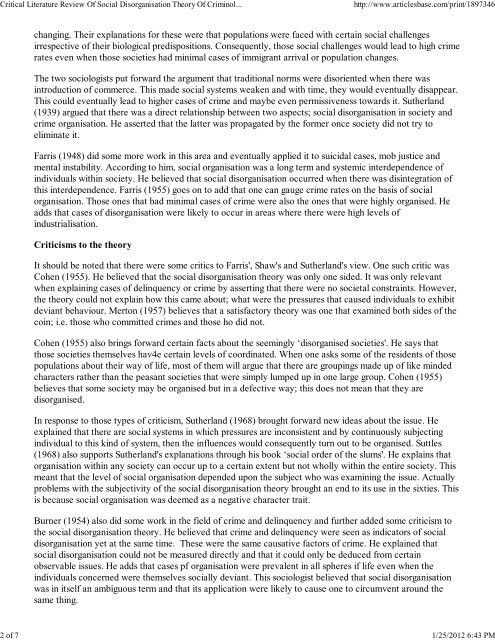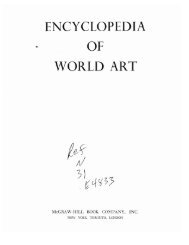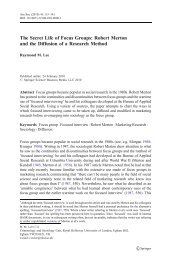Critical Literature Review Of Social Disorganisation Theory Of ...
Critical Literature Review Of Social Disorganisation Theory Of ...
Critical Literature Review Of Social Disorganisation Theory Of ...
Create successful ePaper yourself
Turn your PDF publications into a flip-book with our unique Google optimized e-Paper software.
<strong>Critical</strong> <strong>Literature</strong> <strong>Review</strong> <strong>Of</strong> <strong>Social</strong> <strong>Disorganisation</strong> <strong>Theory</strong> <strong>Of</strong> Criminol...http://www.articlesbase.com/print/18973462 of 7 1/25/2012 6:43 PMchanging. Their explanations for these were that populations were faced with certain social challengesirrespective of their biological predispositions. Consequently, those social challenges would lead to high crimerates even when those societies had minimal cases of immigrant arrival or population changes.The two sociologists put forward the argument that traditional norms were disoriented when there wasintroduction of commerce. This made social systems weaken and with time, they would eventually disappear.This could eventually lead to higher cases of crime and maybe even permissiveness towards it. Sutherland(1939) argued that there was a direct relationship between two aspects; social disorganisation in society andcrime organisation. He asserted that the latter was propagated by the former once society did not try toeliminate it.Farris (1948) did some more work in this area and eventually applied it to suicidal cases, mob justice andmental instability. According to him, social organisation was a long term and systemic interdependence ofindividuals within society. He believed that social disorganisation occurred when there was disintegration ofthis interdependence. Farris (1955) goes on to add that one can gauge crime rates on the basis of socialorganisation. Those ones that had minimal cases of crime were also the ones that were highly organised. Headds that cases of disorganisation were likely to occur in areas where there were high levels ofindustrialisation.Criticisms to the theoryIt should be noted that there were some critics to Farris', Shaw's and Sutherland's view. One such critic wasCohen (1955). He believed that the social disorganisation theory was only one sided. It was only relevantwhen explaining cases of delinquency or crime by asserting that there were no societal constraints. However,the theory could not explain how this came about; what were the pressures that caused individuals to exhibitdeviant behaviour. Merton (1957) believes that a satisfactory theory was one that examined both sides of thecoin; i.e. those who committed crimes and those ho did not.Cohen (1955) also brings forward certain facts about the seemingly ‘disorganised societies'. He says thatthose societies themselves hav4e certain levels of coordinated. When one asks some of the residents of thosepopulations about their way of life, most of them will argue that there are groupings made up of like mindedcharacters rather than the peasant societies that were simply lumped up in one large group. Cohen (1955)believes that some society may be organised but in a defective way; this does not mean that they aredisorganised.In response to those types of criticism, Sutherland (1968) brought forward new ideas about the issue. Heexplained that there are social systems in which pressures are inconsistent and by continuously subjectingindividual to this kind of system, then the influences would consequently turn out to be organised. Suttles(1968) also supports Sutherland's explanations through his book ‘social order of the slums'. He explains thatorganisation within any society can occur up to a certain extent but not wholly within the entire society. Thismeant that the level of social organisation depended upon the subject who was examining the issue. Actuallyproblems with the subjectivity of the social disorganisation theory brought an end to its use in the sixties. Thisis because social organisation was deemed as a negative character trait.Burner (1954) also did some work in the field of crime and delinquency and further added some criticism tothe social disorganisation theory. He believed that crime and delinquency were seen as indicators of socialdisorganisation yet at the same time. These were the same causative factors of crime. He explained thatsocial disorganisation could not be measured directly and that it could only be deduced from certainobservable issues. He adds that cases pf organisation were prevalent in all spheres if life even when theindividuals concerned were themselves socially deviant. This sociologist believed that social disorganisationwas in itself an ambiguous term and that its application were likely to cause one to circumvent around thesame thing.




